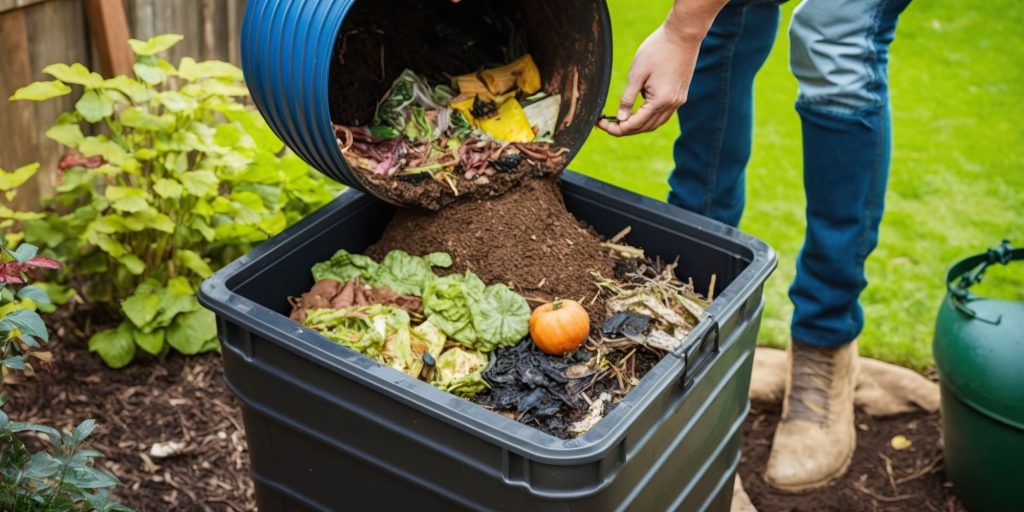Composting is a natural process where organic material, such as vegetable peels and coffee grounds, decompose into a nutrient-rich soil conditioner. This process is often facilitated by microorganisms like bacteria, fungi, and larger creatures like worms and beetles.
This simple yet transformative art can turn your everyday kitchen waste into a valuable resource for your garden. This article will show you how. It’ll guide you through the process, from setting up your compost bin to maintaining it for the best results.
But first, how do you choose the perfect compost bin?
Choosing Your Compost Bin

The first step in the art of composting is choosing the right bin. There are many types of compost bins available, each with its unique features and benefits. Here are some:
- Traditional compost bins – These bins, usually stationary, are ideal for larger gardens and can handle a significant amount of waste. They are simple to use but require manual turning of the compost.
- Compost tumblers – These are barrel-shaped bins that are mounted on a stand. They’re a good option if you have a medium-sized garden.
- Worm composters – Also known as vermicomposting bins, these use worms to help break down organic material. They are a great option for composting kitchen waste in smaller spaces, including indoors.
- Green cone digesters – These are designed for food waste only. You’ll often need to partially bury these bins in the ground. When the waste gets digested, it’ll seep directly into the surrounding soil.
- Bokashi bins – Bokashi composting is a method that uses a specific group of microorganisms to anaerobically ferment organic waste. It can handle almost all types of kitchen waste, including things like meat and dairy, which are usually not recommended for traditional composting.
Your choice of bin will depend on factors like available space, the amount of waste, and your compost management ability. Once you’ve chosen your bin, you’ll need to properly set it up.
Setting Up Your Compost Bin
When setting up your bin, consider the following best practices:
- Choose a spot that’s easily accessible all year round. Ideally, it should be near a water source and preferably shaded to maintain a consistent temperature.
- Start with a layer of browns (dry leaves, twigs, or shredded paper) for carbon. Add a layer of greens (kitchen scraps, coffee grounds, or grass clippings) for nitrogen. Repeat these layers until the bin is full.
- Ensure that your compost pile is damp but not wet. This can allow for air circulation.
- Turn the pile every few weeks to help add air and speed up the composting process.
- Ensure your bin is appropriately sized for your needs. A small bin might fill quicker but be slower to compost. Conversely, while a larger bin takes longer to fill, it might generate compost more quickly.
Following this process can ensure your compost bin works optimally. However, for the composting process to function correctly, you need to maintain the pile properly until it’s ready.
Maintaining Your Compost Pile: Best Practices
Here are some best practices for maintaining a compost bin.
- Ensure a good balance between nitrogen-rich green materials (like vegetable scraps and grass clippings) and carbon-rich brown materials (like dried leaves and paper). A good ratio is 2:1 browns to greens.
- Turn your compost regularly to aerate the pile and speed up the composting process. Once a week is enough to ensure this.
- Maintain moisture levels to ensure your compost pile remains damp but not overly wet, similar to the feel of a wrung-out sponge. If it’s too dry, add water. If it’s too wet, add more brown materials.
- Larger items take longer to decompose. Chop or shred them into smaller pieces to speed up the composting process.
- A hot compost pile decomposes faster. If your pile is not heating up, it might need more green materials or turning.
- Avoid composting meat and dairy. These can attract pests and create unpleasant odors. Stick to plant-based kitchen waste.
- If your compost pile smells, it might be too wet or lack oxygen. Turn it and add more browns if necessary.
Whether you’re planning to grow fruits in your backyard or vegetables in your greenhouse, following these best practices can help you successfully realize your gardening goals.
Compost Today
When well done, composting can significantly enrich your garden. The advice provided in this article can equip you to do it better and reap these benefits. Don’t shy away from seeking further help – composting services and experts are always there to assist you.
So, what are you waiting for? Get a compost bin from your local store and let the composting adventures begin.



